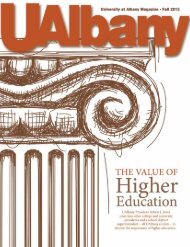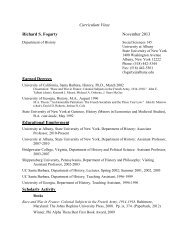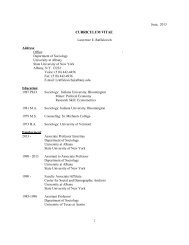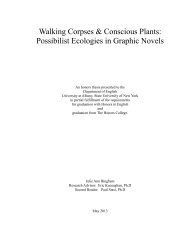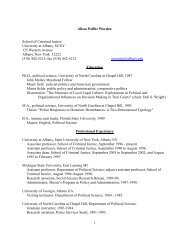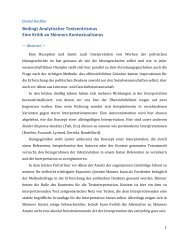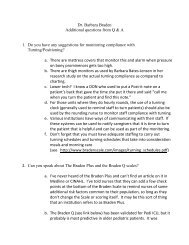Steve Aos - University at Albany
Steve Aos - University at Albany
Steve Aos - University at Albany
You also want an ePaper? Increase the reach of your titles
YUMPU automatically turns print PDFs into web optimized ePapers that Google loves.
typically do not exhibit unit roots after differencing once. As noted above, there is also<br />
considerable concern in the research liter<strong>at</strong>ure on the econometric implic<strong>at</strong>ion of the possible<br />
simultaneous rel<strong>at</strong>ionship between the variables of interest in equ<strong>at</strong>ion (1): th<strong>at</strong> is, crime may be a<br />
function of ADP, but ADP may also be a function of crime. This simultaneous rel<strong>at</strong>ionship can cause<br />
st<strong>at</strong>istically biased estim<strong>at</strong>es if not dealt with.<br />
In order to produce a “crime impact st<strong>at</strong>ement,” marginal effects from this generic log-log crime<br />
model are then obtained with:<br />
In equ<strong>at</strong>ion (2), the change in crime is estim<strong>at</strong>ed with E, the crime-prison elasticity obtained from<br />
coefficient b of the typical loglog estim<strong>at</strong>ion of equ<strong>at</strong>ion (1); UCR, the reported crime r<strong>at</strong>e; ADP, the<br />
incarcer<strong>at</strong>ion r<strong>at</strong>e, and RR<strong>at</strong>e, the reporting r<strong>at</strong>e to police by crime victims. The marginal effects<br />
are sometimes calcul<strong>at</strong>ed either <strong>at</strong> the mean values for ADP-UCR-RR<strong>at</strong>es or, more to the point for<br />
policy purposes, <strong>at</strong> the most recent values for ADPUCR-RR<strong>at</strong>es. The log-log estim<strong>at</strong>ion of the<br />
constant elasticity E implies diminishing returns when E is less than one and incarcer<strong>at</strong>ion r<strong>at</strong>es are<br />
raised. Similarly, an elasticity less than one coupled with reduced ADP implies increasing returns.<br />
To understand the needs for improved research, it is instructive to examine current limit<strong>at</strong>ions in<br />
both the d<strong>at</strong>a and methodological assumptions in equ<strong>at</strong>ion (1).<br />
We can begin with the dependent variable, crime. In the studies estim<strong>at</strong>ing these types of<br />
equ<strong>at</strong>ions, crime is most often measured with d<strong>at</strong>a from the FBI’s UCR. These d<strong>at</strong>a count the<br />
number of crimes reported to police. Some studies estim<strong>at</strong>e a model of total UCR crime reported<br />
to police, while other studies estim<strong>at</strong>e two equ<strong>at</strong>ions, one for violent crime reported to police, and<br />
another for property crime reported to police. Still other studies break the analysis down further<br />
and estim<strong>at</strong>e equ<strong>at</strong>ions for the seven major types of “Part 1” crimes in the UCR d<strong>at</strong>a: murder, rape,<br />
robbery, aggrav<strong>at</strong>ed assault, burglary, theft, and motor vehicle theft.<br />
One significant problem with the “Part 1” UCR crime d<strong>at</strong>a is th<strong>at</strong> they do not m<strong>at</strong>ch directly how<br />
some st<strong>at</strong>es, including Washington, define felony crimes. In Washington, this applies to two types<br />
of crimes in particular: felony sex crimes and theft/larceny. The UCR sex offense d<strong>at</strong>a only count<br />
rapes of females over the age of 12. In addition to this obvious limit<strong>at</strong>ion in the UCR d<strong>at</strong>a, there are<br />
other felony sex crimes (e.g., child molest<strong>at</strong>ion), defined by the Revised Code of Washington th<strong>at</strong><br />
are not included in the UCR rape c<strong>at</strong>egory. Similarly, the UCR d<strong>at</strong>a count some types of theft crimes<br />
th<strong>at</strong> are below the threshold of felony theft in Washington. Therefore, adjustments to the UCR<br />
d<strong>at</strong>a are needed to better m<strong>at</strong>ch the d<strong>at</strong>a needs for actual policy making in the st<strong>at</strong>es. A<br />
comprehensive st<strong>at</strong>e-by-st<strong>at</strong>e review of criminal codes and ways to adjust the UCR d<strong>at</strong>a needs to be<br />
undertaken.<br />
We can then examine the main policy variable, average daily prison popul<strong>at</strong>ion. In virtually all<br />
studies in the current research liter<strong>at</strong>ure, the policy variable examined is st<strong>at</strong>ewide prison average<br />
4



